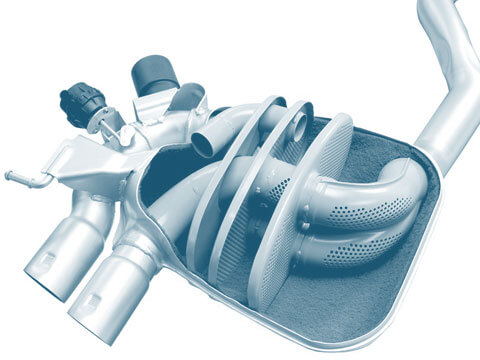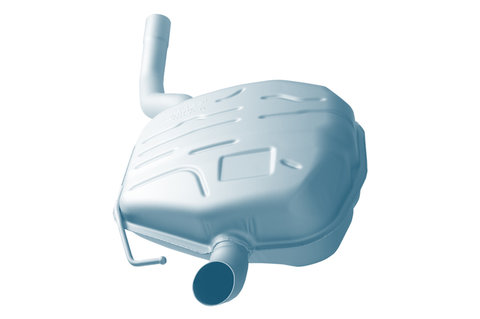End silencers
The end silencer is an essential part of the exhaust system of a passenger car. It plays a decisive role in reducing the noise of the vehicle.
Function
The exhaust noise is produced during the combustion process in the engine by the pulsating exhaust emission from the cylinders. A number of different silencers reduce the noise level within the exhaust system. This is achieved through a combination of sound insulation and sound dampening techniques.
The end silencer usually has special chambers and sound dampening materials that help to absorb and reflect the sound waves before they leave the vehicle. This results in a more pleasant driving experience and promotes compliance with noise regulations.
Sound insulation or absorption
The sound insulation process in the end silencer is based on the principle of sound absorption. There is special sound dampening material inside the end silencer which is used to absorb the sound waves. This material can consist of porous fibres, mats or other absorbent substances. When the sound waves encounter these materials, they are partially converted into heat instead of being reflected as sound. This leads to a decrease in the sound level, as fewer sound waves leave the vehicle.
Sound dampening or reflection
Sound dampening in the end silencer entails the targeted reflection and scattering of sound waves in order to disperse their energy and reduce the noise level. This is achieved through the design of chambers, tubes and internal structures in the end silencer.
Reflection: The inner chambers and tubes of the end silencer are arranged to reflect the sound waves. These reflections cause the sound waves to cancel each other out or at least weaken in intensity.
Resonance: Some end silencers use the principle of resonance absorption, in which certain frequencies of the sound waves are made to resonate. This is done by selecting certain lengths and dimensions for the internal structures. When the sound waves resonate, their energy is effectively absorbed and reduced.
Structure of the end silencer
Casing:
The end silencer consists of a casing which is usually made of aluminised steel or stainless steel. The casing is designed to promote sound insulation and sound dampening in the best possible way. It may contain a number of different chambers, tubes and internal absorption materials.
Sound dampening material:
There is sound dampening material inside the end silencer which serves to reduce the noise level. This material often consists of special fibres, mats or other absorbent materials. These materials have the ability to absorb the sound waves and convert them into heat, which reduces the noise level.
Chambers and tubes:
The inside of the end silencer is split into various chambers and tubes. These are arranged in such a way that they disperse the exhaust gas flow and reflect the sound waves. The reflection and resonance of the sound waves help to reduce noise even further by dispersing and minimising the sound energy.
Catalyst (optional):
Modern end silencers can also contain an integrated catalytic converter. This catalytic converter helps to reduce harmful emissions by converting harmful gases such as nitrogen oxides and carbon monoxide into less harmful substances. The combination of noise reduction and emission control makes the end silencer an important element of the environmental protection strategy.
Connecting tubes:
The end silencer is connected to the front part of the exhaust system via connecting tubes. These tubes route the exhaust gas flow to the silencer and then on to the rear of the vehicle. The design and length of these tubes can affect the acoustic properties and performance of the end silencer.
Tailpipe:
The tailpipe is the visible part of the end silencer that protrudes from the rear section of the vehicle. It can come in various shapes, sizes and materials, which influences the aesthetic appearance of the vehicle. The tailpipe has no direct influence on the function of the end silencer, but it does play a role in its external appearance.
Benefits of noise reduction
The noise reduction made possible by the end silencer has several benefits:
- Passenger comfort: A quieter vehicle significantly improves passenger comfort by minimising irritating engine noise and creating a more pleasant driving environment.
- Legal regulations: Many countries have strict noise restrictions for vehicles. An effective end silencer enables manufacturers to comply with these regulations.
- Environmental friendliness: Reducing traffic noise helps to reduce pollution in urban areas and therefore assists with environmental protection.
Environmental protection
The end silencer helps to reduce harmful emissions by routing the exhaust gas flow and partially filtering the pollutants it contains. Modern end silencers can be fitted with catalytic converters, which help to convert harmful gases such as nitrogen oxides and carbon monoxide into less harmful substances.
Value retention
A well-serviced end silencer can also have a positive influence on the vehicle’s value retention. A properly functioning end silencer can help to ensure that the vehicle passes the mandatory emission tests.








